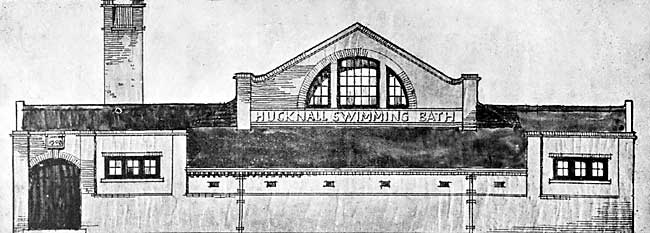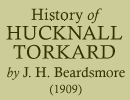< Previous | Contents | Next >
GARDENS.
Gardening is a favourite occupation of Hucknall men; there are 1,700 allotments, measuring from 400 to 600 yards, besides several hundred smaller patches attached to dwellings. The following list shows by whom the larger number of gardens are let on lease: —
|
Gardens. |
| Duke of Portland | 902 |
| Cottage Garden Association | 200 |
| Montagu Trustees | 128 |
| The Vicar | 27 |
| Great Northern Railway Co. | 28 |
| Mr. Widdowson | 33 |
| Hucknall Colliery Co | 50 |
| District Council | 103 |
| Linby Colliery Gardens | 209 |
The land allotted to Hucknall men by the Montagu Trustees and Linby Colliery Co. are in Linby parish, and adjoin the Hucknall boundary. The Common Gardens were set out in 1844 on the land allotted to the poor in 1771, when the commonable lands were enclosed, in response to a request from a number of parishioners made to the Churchwardens and Overseers. Mr. John Price held the land, and received £40 for his tenant right, a sum that was raised by small weekly sums by the prospective gardeners. These men levelled the ground, and made the roads, the farmers lending horses and carts. In 1874 party feeling ran high in the parish, and an attempt was made to thwart the policy of the gardenholders' committee, but the latter were strengthened in their action by a County Court decision, and matters have run smoothly ever since.
BATHS.
In the old days the youth of the village bathed in the river Leen.
About the year 1870 the Local Board dammed up the brook which flows through the Albert Street playing field (then called the "Cricket Field"), and erected a screen for the protection of bathers, but in a few years the bath was silted up, and the screen pulled down.
In 1893 the Duke of Portland gave 2,300 yards of land in Wigwam Lane for the construction of a bath. The District Council made the bath (which was fed by the Town Brook), and erected a corrugated iron building around it.

Opened A.D. 1909.
In 1909 this was replaced by a commodious set of up-to-date baths erected at a cost of £3,300, and presented to the town by the Right Hon. John E. Ellis, M.P.
FINANCE.
The town debt on April 30th, 1907, stood at £13,435, or 17/7 per head of the population, and a penny rate produced £142.
RATEABLE VALUE.
The growth of material prosperity is shown by the increase of rateable property, as follows: —
| Year. RATEABLE VALUE | |
| 1837 | £3,119 |
| 1861 | £6,037 |
| 1870 | £10,000 |
| 1877 | £23,783 |
| 1889 | £28,868 |
| 1899 | £36,267 |
| 1909 | £42,862 |
THE CEMETERY.
Soon after the year 1880 the rapid filling up of the Churchyard caused steps to be taken for the provision of a Cemetery.
A Burial Board was elected in 1884, and the surface of the ground was tested in several parts of the parish with a view of getting a plot free from hard limestone, and where excavation would be comparatively easy. Such a spot was found on sandy strata at the Moss Leys, and eight acres of land there was bought, in the year 1884, from the Duke of Portland at £250 per acre.
The Board borrowed £4,500, repayable in 60 half-yearly instalments of £129 9s. 2d.: the last moiety will be paid in December, 1915.
The Cemetery Chapel, built by Mr. J. A. Munks, cost £1,031.
The question arose as to whether a portion of the area should be set apart and consecrated, but the Burial Board, supported by many ratepayers, objected, and the project dropped.
The first interment took place on August 27th, 1887, and up to December 31st, 1908, there had been 5,319 interments in 4,078 of the total 9,761 grave spaces in the cemetery, leaving 5,683 grave plots available for future use.
During the last ten years interments have averaged 250 per year.
POPULATION.
Hucknall was sparsely populated for centuries. In the 18th century the introduction of the stocking-making industry caused an influx of people. The increase of inhabitants by natural means continued till the opening of coal pits in the parish and neighbourhood.
The following table shows the growth of people in the parish: —
| Year. | Population. | Houses. |
| 1801 | 1,497 | — |
| 1821 | 2,028 | 330 |
| 1831 | 2,200 | — |
| 1841 | 2,680 | — |
| 1851 | 2970 | — |
| 1861 | 2,836 | 661 |
| 1871 | 4,257 | 895 |
| 1878 | — | 1740 |
| 1881 | 10,023 | — |
| 1891 | 13,094 | 2513 |
| 1901 | 15,250 | 3126 |
In 1821 the census was taken by Thomas Starr (churchwarden) and Jonathan Butler (overseer). There were then 1,070 males and 958 females in the parish. There was one person only—a female—over 90 years of age. Seventy families were employed in agriculture, two hundred and twenty in trade, and forty-nine unemployed.
In 1901 nine houses were in course of erection and 132 houses were empty at the time the census was taken. There was only one one-roomed house in the town, and that was empty, but there were 62 houses containing only two rooms each, and in one of these seven people were living, and in two of these houses six people dwelt, and five more of these little places gave shelter to five people each. There were 682 houses containing less than four rooms each, and in three of these there were communities of twelve or more people living. There were 7,622 males and 7,628 females.
The occupations of the people over ten years of age is interesting. Of the males there were 756 who did not work for their living, being either in retirement or invalids. Of the remaining 4,867 adult males, 52 were clerks, 223 engaged in conveying people, goods, or messages; 118 employed in agriculture, 3.081 in mining; 63 in engineering, 20 in cycle and vehicle construction, 242 in building, 27 in wood-working, 15 in paper, printing, and stationery, trades; 159 in hosiery, 3 in lacemaking, 18 other textile workers, 154 dressmakers, 265 in the tobacco, food, and drink businesses, and 427 in other occupations.
In respect to the adult female population, 4,069 were retired, housewives, etc., and of the remaining women workers 1,183 were single and 261 married, engaged as follows:—88 teachers, 180 domestic servants, 23 charwomen, 41 laundry and washing, 319 hosiery, 33 lace, 14 other textile workers, 204 tailoresses, shirt and dressmakers, and seamstresses; 62 engaged in food, drink, and lodging businesses; 348 tobacco workers, and 132 in all other occupations.
As an indication of the thrift of the people, it may be stated that in 1908 there were 440 freeholders in the parish.
